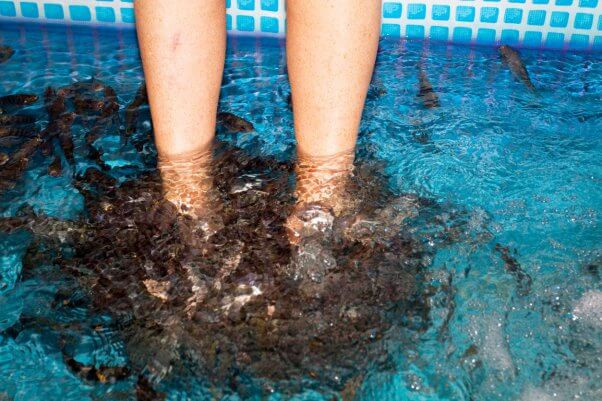Fish Spa Pedicures, once a novelty beauty trend, have faced bans in numerous locations across the U.S., Canada, and Europe. These bans are not arbitrary; they stem from significant concerns about both health risks and the inherent cruelty inflicted upon the fish used in these procedures. Understanding these issues is crucial before considering this type of pedicure.
The primary fish species employed in fish pedicures, Garra rufa, are not naturally inclined to consume dead human skin. This behavior is a direct result of severe starvation. In their natural habitats, these fish feed on algae and plankton. The demand for fish pedicures forces them into conditions where they are deprived of their natural food sources, compelling them to seek sustenance from human skin, a far cry from their dietary needs.
These fish originate mainly from regions in Turkey, Syria, Iraq, and Iran. The unsustainable demand for fish spas has led to overfishing of Garra rufa in their native Turkish habitats. The Turkish government has been compelled to implement legal protections to safeguard these fish from further exploitation and prevent ecological damage due to their removal from natural ecosystems.
The accessibility of these fish to anyone with purchasing power exacerbates the problem. Importers readily ship Garra rufa across borders, often in inadequate conditions. The fish are typically transported in water-filled plastic bags, a stressful and often fatal journey for these delicate creatures, many of whom do not survive the transit to pedicure spas.
When fish pedicure tubs are in constant use, maintaining adequate hygiene becomes virtually impossible. Effective disinfection between clients is not feasible when the tubs are populated with live fish. Furthermore, there is no practical way to sanitize the fish themselves. This creates a significant risk of cross-contamination, especially concerning given that individuals with contagious conditions like nail fungus and athlete’s foot are often drawn to fish pedicures, seeking a perceived exfoliation benefit.
Adding to the hygiene concerns, fish, like all living beings, produce waste. In fish pedicure tubs, this waste accumulates, further compromising the cleanliness of the water and creating a breeding ground for bacteria. This unsanitary environment poses a direct threat to the health of individuals undergoing the treatment.
For those seeking effective and even exfoliation, a pumice stone remains the superior and safer choice. Fish lack the precision and control of a trained nail technician. They cannot target specific areas requiring exfoliation, leading to inconsistent results. Reports from individuals who have experienced fish pedicures include instances of uneven skin texture and areas where the fish have bitten too aggressively, causing bleeding and potential injury.
Fish pedicure tubs, with their warm water and organic waste, become ideal breeding grounds for various bacteria. Even minor cuts or pre-existing sores on the feet can become easily infected when submerged in these bacteria-laden environments. The risk of bacterial infections is significantly heightened in fish spas compared to traditional pedicure methods.
Alarmingly, Garra rufa fish themselves have been found to be carriers of several types of bacteria that can cause infections in humans. These include Streptococcus agalactiae, a bacterium known to cause pneumonia, and other antibiotic-resistant bacteria strains. This poses a direct health risk to individuals undergoing fish pedicures, as these bacteria can be transmitted through the water and fish.
Fish are sentient beings capable of feeling stress and pain. They are not inanimate tools to be used for cosmetic procedures. Choosing a fish spa pedicure supports a practice that is not only potentially harmful to human health but also undeniably cruel to animals. Opting for a safe, hygienic, and cruelty-free pedicure from a qualified human technician or performing a DIY pedicure at home are ethical and healthier alternatives.






